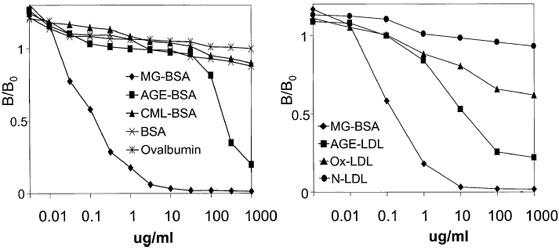Anti-Advanced Glycation End Products (AGE), Methylglyoxal (MG) [3D11] Antibody
This IgG monoclonal antibody was generated against methylglyoxal (MG)-modified ovalbumin, and is reactive against human, mouse and rat MG.
Highlights:
- Reacts with human, mouse and rat MG
- Suitable for Western Blot, ELISA and Immunohistochemistry applications
Recombinant versions available from our sister company, Absolute Antibody:
- Manufactured using Absolute Antibody’s Recombinant Platform with variable regions (i.e., specificity) from the hybridoma 3D11.
Methylglyoxal (MG) also referred to as pyruvaldehyde or 2-oxopropanal is formed as a side product of several metabolic pathways. Importantly, it has shown to be involved in the formation of advanced glycation end products otherwise known as AGEs. AGEs are formed both outside and inside the body. AGEs are substances that can be a factor in the development or worsening of many degenerative diseases including Diabetes and Alzheimer's disease.
From the laboratory of Helen Vlassara, MD, Icahn School of Medicine at Mount Sinai.
This IgG monoclonal antibody was generated against methylglyoxal (MG)-modified ovalbumin, and is reactive against human, mouse and rat MG.
Highlights:
- Reacts with human, mouse and rat MG
- Suitable for Western Blot, ELISA and Immunohistochemistry applications
Recombinant versions available from our sister company, Absolute Antibody:
- Manufactured using Absolute Antibody’s Recombinant Platform with variable regions (i.e., specificity) from the hybridoma 3D11.
Methylglyoxal (MG) also referred to as pyruvaldehyde or 2-oxopropanal is formed as a side product of several metabolic pathways. Importantly, it has shown to be involved in the formation of advanced glycation end products otherwise known as AGEs. AGEs are formed both outside and inside the body. AGEs are substances that can be a factor in the development or worsening of many degenerative diseases including Diabetes and Alzheimer's disease.
From the laboratory of Helen Vlassara, MD, Icahn School of Medicine at Mount Sinai.
| Catalog Number | Product | DataSheet | Size | AVAILABILITY | Price | Qty |
|---|
| Product Type: | Antibody |
| Name: | AGE, Methylglyoxal [3D11] Antibody |
| Accession ID: | Q15109 |
| Molecular Weight: | 45.4 kDa |
| Isotype: |
EMS301: IgG2a Recombinant versions: see product name |
| Clonality: | Monoclonal |
| Clone Name: | 3D11 |
| Reactivity: | Human, Mouse, Rat |
| Immunogen: | MG-modified ovalbumin |
| Species Immunized: | Mouse |
| Purification Method: | Protein G Affinity Chromatography |
| Buffer: |
EMS301: 0.1M Sodium Phosphate, pH 7.4, 0.15M NaCl, 0.05% (w/v) Sodium Azide Recombinant versions: PBS with 0.02% Proclin 300 |
| Tested Applications: | WB (1:800-2000), IHC (1:10-20), ELISA (1:1000) |
| Storage: | -20C |
| Shipped: | Cold packs |
Binding inhibition curve of anti-MG derivative (MG3D11)

Affinity of mouse monoclonal antibody (MG3D11) was determined by a competitive ELISA. Competitive inhibition of antibody binding by modified and unmodified proteins (left) or lipid lipoprotein preparations (right)
Adapted from: Cai W., et. al Mol Med 8: 337-346, 2002.
- Cai W., Gao G.D., Zhu L., Peppa M., Vlassara H. Oxidative stress-inducing carbonyl compounds from commn foods: novel mediators of cellular dysfunction. Mol Med 8: 337-346, 2002.
- Vlassara H, Cai W, Crandall J, Goldberg T, Oberstein R, Dardaine V, Peppa M, Rayfield EJ. Inflammatory mediators are induced by dietary glycotoxins, a major risk factor for diabetic angiopathy. roc Natl Acad Sci U S A. 2002 Nov 26;99(24):15596-601.
- Cai W, Ramdas M, Zhu L, Striker GE, Vlassara H. Oral advanced glycation endproducts (AGEs) promote insulin resistance and diabetes by depleting the antioxidant defenses AGE receptor-1 and sirtuin 1. Proc Natl Acad Sci USA 109: 15888-15893, 2012.
If you publish research with this product, please let us know so we can cite your paper.

![Recombinant Anti-Advanced Glycation End Products (AGE), Methylgloxal [3D11], Mouse, IgG2a Product](https://www.kerafast.com/MediaStorage/Product/Images/Medium/5720_20210902083914191.jpg)
